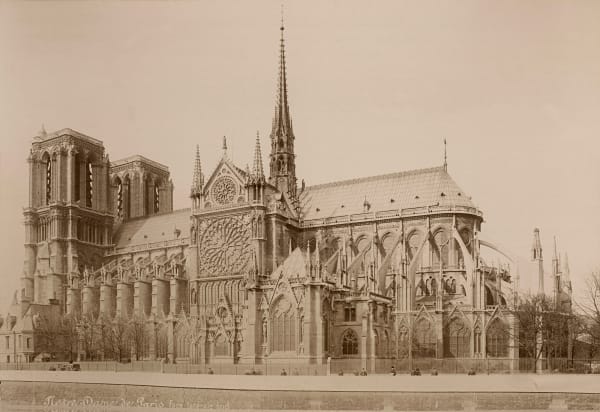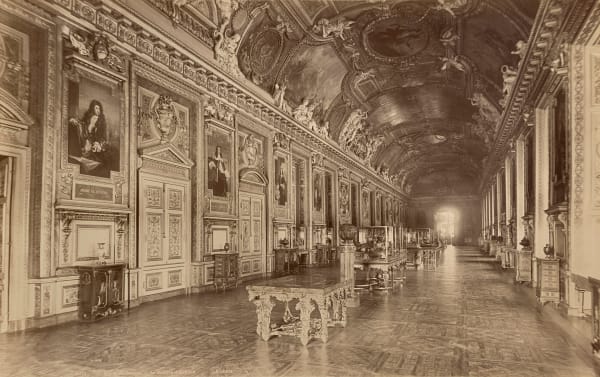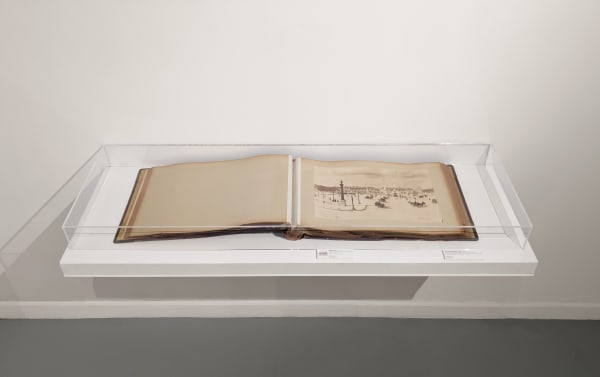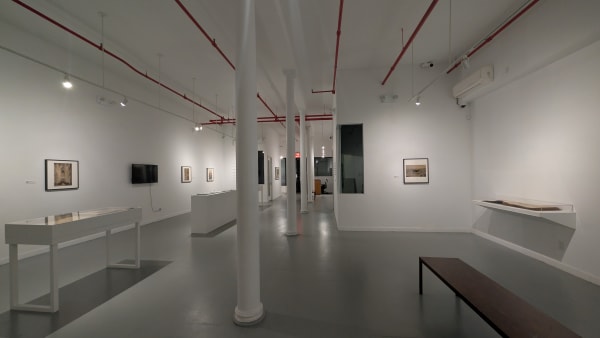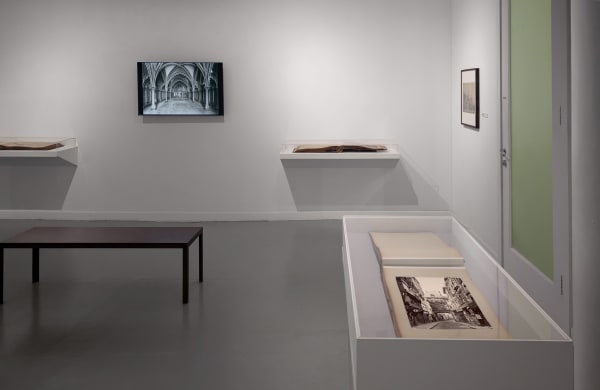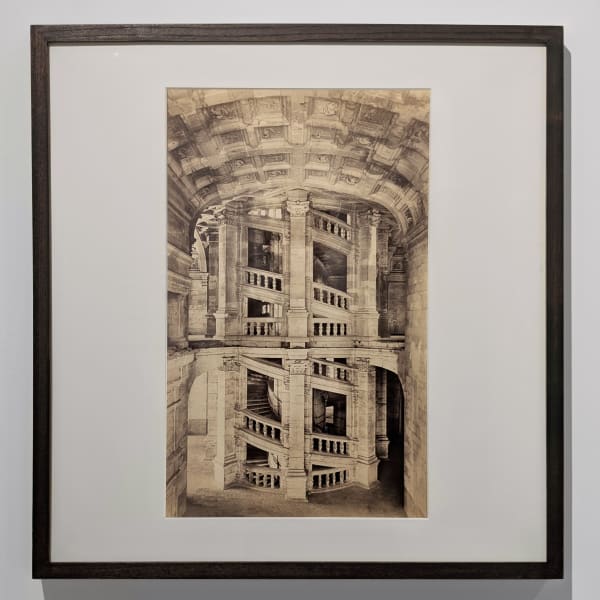Monument Historique: 19th Century Photographs by Séraphin-Médéric Mieusement: and other French photographers
WESTWOOD GALLERY NYC presents Monument Historique, an exhibition of late 19th century photographs by Séraphin-Médéric Mieusement (1840-1905) and other French photographers, compiled within thirteen vintage photographic albums.
Driven by a visionary passion and unmatched professional expertise, Mieusement sought to immortalize the nation’s cultural heritage and patrimony through his extensive phototgraphic survey. Refusing to be confined to a single region, he aspired to capture monuments across all of France. This ambition demanded immense stamina and willpower, as he traversed the country by horse and cart, transporting heavy equipment, glass plate negatives, and the chemicals needed to develop them on-site in a portable darkroom. His unwavering dedication earned recognition from the Commission des Monuments, whose archives remain an invaluable resource for architects and historians to this day.
The exhibition features a selection of the original 19th century albums, a newly-released gallery limited edition of eleven modern prints of Mieusement photos, and facsimiles of all albumen prints for the public to view. More than two hundred and twenty historic French monuments are represented within over five hundred and eighty photographs in the albums spanning from the 1860s-1890s.
This is the premiere exhibition of Séraphin-Médéric Mieusement's photographs in New York City, and the first time the vintage albums will be on view in over 100 years.
The exhibition, curated by James Cavello is on view January 24 – April 5, 2025.
-
 Séraphin-Médéric Mieusement, Cathédrale Notre-Dame de Paris: face latérale sud, Île-de-France, circa 1860s-90s
Séraphin-Médéric Mieusement, Cathédrale Notre-Dame de Paris: face latérale sud, Île-de-France, circa 1860s-90s -
 Séraphin-Médéric Mieusement, Chateau de Pierrefonds: Côte de l’entrée, Oise, Hauts-de-France, circa 1860s-90s
Séraphin-Médéric Mieusement, Chateau de Pierrefonds: Côte de l’entrée, Oise, Hauts-de-France, circa 1860s-90s -
 Séraphin-Médéric Mieusement, Blois Eglise St. Laumer, Loir-et-Cher, Centre-Val de Loire, circa 1860s-90s
Séraphin-Médéric Mieusement, Blois Eglise St. Laumer, Loir-et-Cher, Centre-Val de Loire, circa 1860s-90s -
 Séraphin-Médéric Mieusement, Cathédrale Sainte-Croix d'Orléans: Abside, Loiret, Centre-Val de Loire, circa 1860s-90s
Séraphin-Médéric Mieusement, Cathédrale Sainte-Croix d'Orléans: Abside, Loiret, Centre-Val de Loire, circa 1860s-90s
-
 Séraphin-Médéric Mieusement, Chateau de Gien, Côte de la ville, Loiret, Centre-Val de Loire, circa 1860s-90s
Séraphin-Médéric Mieusement, Chateau de Gien, Côte de la ville, Loiret, Centre-Val de Loire, circa 1860s-90s -
 Séraphin-Médéric Mieusement, Chateau de Josselin, Morbihan, Brittany, circa 1860s-90s
Séraphin-Médéric Mieusement, Chateau de Josselin, Morbihan, Brittany, circa 1860s-90s -
 Séraphin-Médéric Mieusement, Duomo di Milano, Italy, circa 1860s-90s
Séraphin-Médéric Mieusement, Duomo di Milano, Italy, circa 1860s-90s -
 Neurdein Frères, Château de Chambord: Le Grand Escalier, Loir-et-Cher, Centre-Val de Loire, circa 1860s-90s
Neurdein Frères, Château de Chambord: Le Grand Escalier, Loir-et-Cher, Centre-Val de Loire, circa 1860s-90s
-
 Monument Historique: 19th Century Photographs by Séraphin-Médéric Mieusement and other French photographers | Installation View
Monument Historique: 19th Century Photographs by Séraphin-Médéric Mieusement and other French photographers | Installation View -
 Monument Historique: 19th Century Photographs by Séraphin-Médéric Mieusement and other French photographers | Installation View
Monument Historique: 19th Century Photographs by Séraphin-Médéric Mieusement and other French photographers | Installation View -
 Monument Historique: 19th Century Photographs by Séraphin-Médéric Mieusement and other French photographers | Installation View
Monument Historique: 19th Century Photographs by Séraphin-Médéric Mieusement and other French photographers | Installation View -
 Monument Historique: 19th Century Photographs by Séraphin-Médéric Mieusement and other French photographers | Installation View
Monument Historique: 19th Century Photographs by Séraphin-Médéric Mieusement and other French photographers | Installation View -
 Monument Historique: 19th Century Photographs by Séraphin-Médéric Mieusement and other French photographers | Installation View
Monument Historique: 19th Century Photographs by Séraphin-Médéric Mieusement and other French photographers | Installation View -
 Monument Historique: 19th Century Photographs by Séraphin-Médéric Mieusement and other French photographers | Installation View
Monument Historique: 19th Century Photographs by Séraphin-Médéric Mieusement and other French photographers | Installation View -
 Monument Historique: 19th Century Photographs by Séraphin-Médéric Mieusement and other French photographers | Installation View
Monument Historique: 19th Century Photographs by Séraphin-Médéric Mieusement and other French photographers | Installation View -
 Monument Historique: 19th Century Photographs by Séraphin-Médéric Mieusement and other French photographers | Installation View
Monument Historique: 19th Century Photographs by Séraphin-Médéric Mieusement and other French photographers | Installation View -
 Monument Historique: 19th Century Photographs by Séraphin-Médéric Mieusement and other French photographers | Installation View
Monument Historique: 19th Century Photographs by Séraphin-Médéric Mieusement and other French photographers | Installation View -
 Monument Historique: 19th Century Photographs by Séraphin-Médéric Mieusement and other French photographers | Installation View
Monument Historique: 19th Century Photographs by Séraphin-Médéric Mieusement and other French photographers | Installation View
WESTWOOD GALLERY NYC presents Monument Historique, an exhibition of late 19th century photographs by Séraphin-Médéric Mieusement (1840-1905) and other French photographers, compiled within thirteen vintage photographic albums.
The exhibition features a selection of the original 19th century albums, a newly-released gallery limited edition of eleven modern prints of Mieusement photos, and facsimiles of all albumen prints for the public to view. More than two hundred and twenty historic French monuments are represented within over five hundred and eighty photographs in the albums spanning from the 1860s-1890s. This is the premiere exhibition of Séraphin-Médéric Mieusement's photographs in New York City, and the first time the vintage albums will be on view in over 100 years. The exhibition is curated by James Cavello and will be on view January 24 – April 5, 2025, with an opening reception on Thursday January 23 from 6:00 to 8:00pm.
By the 19th century, the preservation and restoration of historic monuments was a relatively novel concept in most countries. In France, it was the upheaval of the 1790s Revolution that ignited a pressing call for a national archival endeavor, ensuring future generations could explore, study, and draw inspiration from the architectural artistry, landscapes, materials, and craftsmanship of the past, forging a bridge from the cultural splendor of past to the present. In 1837, the Commission des monuments historiques was established in France to classify, maintain, and restore historical monuments. In 1840, three events occurred that would contribute immensely to preservation efforts: the Commission published its first list of historical monuments, English scientist Henry Fox Talbot invented the photographic paper negative (Calotype), and photographer Séraphin-Médéric Mieusement was born in Gonneville-la-Mallet. Soon thereafter, campaigns to protect and maintain historic French monuments would become inextricably tied to the practice of photography.
By 1859, at the age of nineteen, Séraphin-Médéric Mieusement was already an established photographer in France, working under acclaimed architects who were documenting and undertaking restoration projects carried out by the Commission. Mieusement would go on to work closely with the Commission des monuments historiques, producing photographs that expanded upon and filled in the gaps of the Commission’s growing photographic archive. A distinguished name in the field of architectural photography, Mieusement was called upon by other organizations of the time, including the Ministère des Cultes. From the 1850s to early 1900s, Mieusement captured thousands of sites across France – encapsulating singular moments in the long and tumultuous lives of these historic structures.
Mieusement distinguished himself among the photographers tasked with documenting France’s monuments in need of restoration. Driven by a visionary passion and unmatched professional expertise, he sought to immortalize the nation’s cultural heritage and patrimony. Refusing to be confined to a single region, he aspired to capture monuments across all of France. This ambition demanded immense stamina and willpower, as he traversed the country by horse and cart, transporting heavy equipment, glass plate negatives, and the chemicals needed to develop them on-site in a portable darkroom. His unwavering dedication earned recognition from the Commission des Monuments, whose archives remain an invaluable resource for architects and historians to this day.
Included in the exhibition are eleven modern limited-edition photographs restored from the original albumen prints – seven by Mieusement and four by the Neurdein Brothers, who had a photography studio in Paris. Three exceptional views include the Notre-Dame Cathedral of Paris photographed with its 1853 spire, of which only a third remains after the devastating 2019 fire; the extraordinary 16th century double-helix staircase of the Château de Chambord exposed across two stories in a rare moment in which the floor was removed; and the Louvre Palace edition print photographed by Mieusement with a full view of the main courtyard, ‘Cour Napoleon’, over one hundred years before the 1984 addition of I. M. Pei’s iconic glass pyramid.
Accompanying the modern prints, the vintage photographs from the thirteen vintage photographic albums are represented in their entirety through rotating images on gallery monitors as well as in printed materials on view. The wide breadth of photographs, from the cloisters of the Mont-Saint-Michel Abbey to the rooms of Palace of Versailles, go beyond architectural documentation. In one extraordinary example, Mieusement positioned himself at Notre-Dame’s south tower facing the spire, and photographed a chimère – the squatting ape – seated with crossed arms and knees pressed tight up against its chest as it looks across the rooftop to a clock on a far roof that reads 1:15pm – both frozen in time. Mieusement knew the importance of this historic project and documented his architectural subjects while maintaining the artistic and aesthetic standards of his photographic practice. The photographs in Mieusement’s collection not only served as indispensable records for the Commission, but they themselves have come to constitute objects of cultural heritage.
Although the grand castles, chateaus and cathedrals that exist today of Josselin, Pierrefonds, Notre-Dame de Paris, the Palace of Versailles, and the Duomo of Milan, these architectural wonders may never again be experienced as they were in the late 19th century – moments preserved within Mieusement’s albumen prints like fossils in amber.
The gallery program focuses on historic and contemporary artists and photographers to reestablish their importance in art history. Westwood Gallery NYC’s previous premiere historic photography exhibitions to re-examine and re-contextualize important work include exhibitions of John Thomson (1837-1921), Leo Matiz (1917-1998), Lazhar Mansouri (1932-1985), Lucien Clergue (1934-2014), Bob Adelman (1930-2016), Roy Schatt (1909-2002), Jacques Lowe (1930-2001) and many others, re-discovered by gallery co-owner/curator, James Cavello.
----
Séraphin-Médéric Mieusement (1840-1905) was a French architectural photographer born in Gonneville-la-Mallet, a commune in the Seine-Maritime department in the Normandy region of Northern France. As a young man, he established himself as a photographer in Blois in the Loire Valley and worked for acclaimed architects including Jacques Félix Duban (1798-1870), Anatole de Baudot (1834-1915), and Eugène Viollet-le-Duc (1814-1879) to provide photographic supplements for restoration projects on historic monuments. Some of his first photographs were of the Château de Blois and the Château de Pierrefonds. At 22 years old, Mieusement had his first exhibition of his photographs in London in 1862, and two years later exhibited at the Société française de photographie in Paris. In 1870, Mieusement’s first four photographs, picturing the Gaston d'Orléans staircase in Blois, entered the collection of the Commission des monuments historiques accompanied by a note from Félix Duban about the ongoing restoration.
In 1872, the photographic collection of the Commission included only around 600 photographic prints of monuments by Édouard Baldus (1813-1889), Hippolyte Bayard (1801-1887), Gustave Le Gray (1820-1884), Henri Le Secq (1818-1882), Auguste Mestral (1812-1884), and others taken two decades earlier. After identifying the gaps in their collection, Mieusement proposed a new, monumental project to the Commission, which included a detailed travel itinerary to photograph designated monuments throughout France to ensure the original architecture would not be lost due to degradation of the structure or to a restructured restored building.
His proposal was unique in offering to include the negatives and three copies of prints, to deliver around thirty-five photographs per month over a ten-year period, comprising over 4,000 photographs at approximately one hundred fifty thousand French francs. His 1872 proposal was refused due to the limited budget of the Commission, which solely financed repairs to buildings. On January 7, 1873, the Commission revised its official list of monuments and the following year amended its budget to include the acquisition of photographs – purchasing prints by Charles Marville (1813-1879), Dominique Roman (1824-1911), Louis-Emile Durandelle (1839-1917), and in late 1874, one hundred and thirty-seven photographs by Mieusement.
Mieuseument began actively working under the Commission des Monuments Historiques, detailing his 1875 journey to the Commission in various towns and cities: "Nevers, Moulins, Lyon, Vienne sur Rhône, Avignon, Arles, Nîmes, Marseille, Toulon, Nice, Vintimille, Genoa, Florence, return via Chambéry, Mâcon and Blois,” to which the Commission responded with a list of monuments in each location. After receiving these commissioned photographs from Mieusement, they tasked him in 1877 with producing three-hundred fifty photographs for L'Exposition universelle de 1878 to highlight the restoration work in monuments across France. The photographer was awarded a silver medal for these photographs and was soon admitted to the French Society of Photography, where he became president of the Society of Artistic Excursions of Loir-et-Cher.
As a trusted photographer associated with the Commission, Mieusement signed contracts with other organizations including the Ministère des Cultes which commissioned Mieusement in 1881 to photograph one category of buildings outside the control of the Commission: cathedrals, which remained solely under the ministère des Affaires ecclésiastiques. In 1883, Mieusement was granted an exclusive sales counter at the Palais du Trocadéro, and permitted to sell the photographs he had taken for the Commission as well as those from his private collection. In 1885, he moved his studio to Paris at 13 Rue de Passy. In 1886, he was granted a second sales counter in the Hôtel de Cluny Museum.
In 1890, after the marriage of Mieusement’s daughter Laure to photographer Paul Robert (1867-1898), Mieusement passed by dowry his contract with the Commission of historic monuments and the management of the Mieusement collection to his son-in-law. Three years later, Mieusement traveled to Algeria on a photographic survey mission for the Ministry of Worship. Upon his return, he continued to work in Provence before retiring in Blois. In 1894, Paul Robert was granted the exploitation of all photographs of the Commission and unified all photographs under the rating Monument Historique. He assisted with organizing and cataloging the photographs of Mieusement, as well as photographing some monuments himself in specific regions of France. In 1897, Paul Robert became the secretary of the Chambre syndicale de la photographie, but died prematurely only a year later. Mieusement’s concession and the exploitation of the photographs in the Commission transferred to the Neurdein Brothers House – a family of French photographers. Other photographers, including Jean-Eugène Durand were hired to document historic monuments for the Commission and Durand’s photographs are included in the vintage photographic albums.
From the late-1870s through the early-1900s, American architect and art historian Russell Sturgis (1836-1909) acquired over 600 photographs by Mieusement, including photos by Paul Robert, to add to his private collection of over fifteen thousand 19th century architectural photographs, now housed in the collection of Washington University.
On September 10, 1905, Miesuement passed away in the oceanside commune of Pornic at the age of 65.

